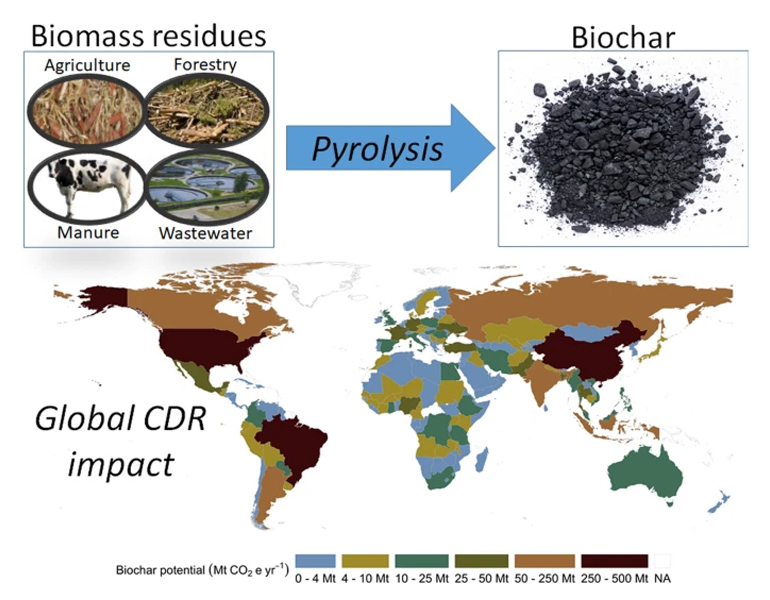Ground-breaking new research commissioned by the International Biochar Initiative (IBI) shows that the carbon dioxide removal (CDR) solution biochar can play a significant role in global emissions reductions at the global and national levels, potentially removing up to 6 percent of global emissions of 3 billion tonnes of carbon dioxide annually.
First developed by Indigenous communities in the Amazon thousands of years ago and now a rapidly expanding global industry, biochar is a material created by heating organic materials — such as forestry and crop residues that would otherwise release emissions when decomposing – in an oxygen-free environment.
通过将这些材料biochar instead, carbon is locked for centuries to millennia.
When used as a soil amendment, biochar can improve soil health and increase water and nutrient retention in soils, helping to both mitigate against and adapt to the effects of climate change.
First-of-its-kind research
Commissioned by the International Biochar Initiative (IBI) and published in the peer-reviewed journalBiochar, the report “Biomass residue to carbon dioxide removal: quantifying the global impact of biochar“, the research quantifies biochar’s carbon dioxide removal (CDR) potential across 155 countries, with net removal potential on a national and global scale, assuming a sustainable supply of no purpose-grown biomass quantities.
Currently providing the vast majority of delivered carbon credits, biochar is an affordable, scalable, and readily available solution that, unlike other CDR methods, also provides environmental and social co-benefits like improved soil health leading to increased crop yields.
This is the first research to quantify the significant role biochar can play in worldwide climate action and carbon removal strategies, at the level of individual countries. To scale biochar to its full potential, we now have a starting point of what is possible at the country level. By considering the climate impact of co-benefits such as fossil fuel displacement, improved crop yields, and healthier soil, we can also go farther, getting a better picture of biochar’s complete climate solution potential, said Dr Thomas Trabold, co-author and research professor at the Rochester Institute of Technology’s Golisano Institute for Sustainability.
Biochar for small-emitting countries important
The greatest carbon dioxide removal (CDR) potential – rests with the world’s biggest emitters, including China, the United States (US), Brazil, and India, who can chart a pathway for sustainable emissions reductions through biochar.

However, biochar also has a minimum removal potential of 10 percent in over 25 countries, concentrated in Africa, South America, and Eastern Europe, and can potentially reduce carbon emissions by over 30 percent in Eswatini (Swaziland) and more than 20 percent in Malawi, Argentina, and Ghana.
The report’s consideration of small-emitting countries is particularly significant. Though many small-emitting countries have contributed the least to climate change, they are experiencing its impacts disproportionately, from soil erosion to extreme weather.
Biochar offers a circular and sustainable approach to climate change mitigation, giving these countries the opportunity to maximize carbon removal while increasing national and local revenues.
It makes agricultural production more sustainable at all scales, from protecting soil security to creating employment opportunities at the community and commercial levels.
For farmers facing multiple challenges related to climate change, biochar is a potential game-changer.
Need for value-chain collaboration
Coined “nature’s black gold” by its advocates, momentum has been building around biochar for decades, though a historic lack of attention and investment has impeded industry growth.
The research emphasizes that with climate urgency growing, now is the time for collaboration at all levels – from policymakers to farmers – to remove supply chain bottlenecks, accelerate investment, and increase long-term demand so the technology can be deployed at scale.
As the global community approaches COP28, this research presents an urgent call to action for world leaders to ensure this powerful solution is in every country’s climate change strategy. Biochar not only safely locks away carbon, but it is also a circular solution to help feed the world, decarbonize the built environment, and remove pollutants in water and soil. To stay on a 1.5°C pathway, we must accelerate biochar use and include it in our climate toolbox, said Wendy Lu Maxwell-Barton, Executive Director of IBI.




